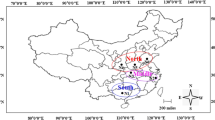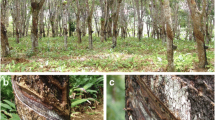Abstract
Pathogenicity tests and inter simple sequence repeat (ISSR) molecular fingerprinting markers were utilized to analyze 24 Corynespora cassiicola isolates obtained from a lot of Hevea clones grown in most rubber nurseries and a few plantations in China. The C. cassiicola isolates were collected from Hainan and Yunnan provinces, China, from 2006 to 2008. The assay of 24 C. cassiicola isolates on detached leaves of four different Hevea rubber clones (genotypes PR 107, Dafeng 95, RRIM 600, and Reyan 7-33-97) indicated that 23 of the isolates were susceptible to RRIM 600, and were therefore considered race 1 except for CC-023. ISSR analysis grouped 24 C. cassiicola isolates into four clusters (A, B, C, and D). Unweighted pair-group method with arithmetic averaging (UPGMA) analysis based on Nei and Li’s coefficient (calculated from the binary matrix data of 103 DNA fragments generated from 16 ISSR primers) indicated that cluster A included 19 isolates from Hainan and Yunnan (this cluster was further divided into two sub clusters (I, II), sub cluster II contained isolate CC-023); clusters B and C comprised of 1 isolates from Hainan, respectively; while cluster D encompassed 3 isolates from Hainan and Yunnan. Pathogenicity tests and ISSR analysis showed that there was no correlation between race structure, the geographical origin of the pathogen and their ISSR clusters because 23 of the isolates belonging to four distinct clusters were considered race 1 except for isolate CC-023. However, most of the isolates with different pathogenicity levels shared the same clades, and furthermore, the ISSR clusters and cology color had an exact correlation. These results should facilitate the development of rubber clones with enhanced resistance against all genetic clusters of C. cassiicola.


Similar content being viewed by others
References
Farr, D. F., Rossman, A. Y., Palm, M. E., & McCray, E. B. (2007). Fungal databases. Systematic Botany & Mycology Laboratory, ARS, USDA. Retrieved Dec 13, from http://nt.arsgrin.gov/fungaldatabases/.
Deighton, F. C. (1936). Preliminary list of fungi and diseases of plants in Sierra Leone. Kew Bulletin, 7, 397–424.
Ramakirishnan, T. S., & Pillai, P. N. R. (1961). Leaf spots of rubber caused by Corynespora cassiicola. Rubber Board Bulletin, 5, 52–53.
Newsam, A. (1961). Plant pathology division report. Rubber Research Institute of Malaysia, Kuala Lumpur, Malaysia.
Awoderu, V. A. (1969). New leaf spot of para rubber (Hevea brasiliensis) in Nigeria. Plant Disease Report, 53, 406–408.
Teoh, C. H. (1983). Corynespora leaf fall of Hevea in West Java. Malaysian Plant Protection Society. Newsletter, 7, 12–13.
Junqeuira, N. T. V., Gasparotto, L., Moraes, V. H. F., Silva, H. M., & Lim, T. M. (1985). New diseases caused by virus, fungi and also bacterium on rubber from Brazil and their impact on international quarantine. In Proceeding of the Regional Conference on Plant Quarantine Support for Agricultural Development (pp. 253–260), 10–12 December, Kuala Lumpur, Malaysia.
Liyanage, A. S., Jayasinghe, C. K., Liyanage, N. I. S., & Jayaratne, A. H. R. (1986). Corynespora leaf spot disease of rubber (Hevea brasillensis) a new record. Journal of the Rubber Research Institute of Sri Lanka, 65, 47–50.
Pongthep, K. (1987). Corynespora disease of Hevea in Thailand. IRRDB’s Symposium on Pathology of Hevea in Chieng Mai, 2–3 November, Thailand.
Rahman, M. A. (1988). Diseases of Hevea brasiliensis in Bangladesh. Bano Biggyyan Patrika, 17, 73–79.
Dung, P. T., & Hoan, N. T. (1999). Corynespora leaf fall on rubber in Vietnam, a New record. In Q. B. Chen & J. N. Zhou (Eds.), Proceeding of IRRDB Symposium 1999 (pp. 273–275). Haikou: Hainnan Publishing House.
Pu, J. J., Zhang, X., Qi, Y. X., Xie, Y. X., Zhang, H. Q., & Zhang, H. (2007). First record of Corynespora leaf fall disease of Hevea rubber tree in China. Australasian Plant Disease Notes, 2, 35–36. doi:10.1071/DN07017.
Shamsul, K. A. S., & Shamsuri, M. H. (1996). Current status of Corynespora leaf fall in Malaysia. In Proceeding of Workshop on Corynespora Leaf Fall Disease of Hevea Rubber (pp. 21–28), Medan, Indonesia.
Wisma, S. S., & Harmidi, S. (1996). Current status of Corynespora leaf fall in Indonesia. In Proceeding of Workshop on Corynespora Leaf Fall Disease of Hevea Rubber (pp. 29–36), Medan, Indonesia.
Tan, A. M., Lo, T. P., Vadivel, G., Bachik, M. S., & Yoon, K. P. (1992). Survey of major leaf diseases of rubber in Peninsular Malaysia. RRIM Planters’ Bulletin, 211, 51–62.
Jayashinghe, C. K., & Silva, W. P. K. (1996). Current status of Corynespora leaf fall in Sri Lanka. In Proceeding Workshop on Corynespora Leaf Fall Disease of Hevea Rubber (pp. 15–19), 16–17 December, Medan, Indonesia.
Ismail, H., & Jeyanayagi, I. (1999). Occurrence and identification of physiological races of Corynespora cassiicola of Hevea. In Q. B. Chen & J. N. Zhou (Eds.), Proceeding of IRRDB Symposium 1999 (pp. 263–272). Haikou: Hainnan Publishing House.
Darmono, T. W., Darussamin, A., & Pawirosoemardjo, S. (1996). Variation among isolates of Corynespora cassiicola associated with Hevea brasiliensis in Indonesia. In Proceeding Workshop on Corynespora Leaf Fall Disease of Hevea Rubber (pp. 79–91), 16–17 December, Medan, Indonesia.
Silva, W. P. K., Karunanayake, E. H., Wijesundera, R. L. C., & Priyanka, U. M. S. (2003). Genetic variation in Corynespora cassiicola: A possible relationship between host origin and virulence. Mycological Research, 107, 567–571. doi:10.1017/S0953756203007755.
Saha, T., Arun, K. A., Sreena, S., Joseph, A., Kuruvilla, J. C., Kothandaraman, R., et al. (2000). Genetic variability of Corynespora cassiicola infecting Hevea brasiliensis isolated from the traditional rubber growing areas in India. Indian Journal of Nature Rubber Research, 13, 1–10.
Atan, S., & Hamid, N. H. (2003). Differentiating races of Corynespora cassiicola using RAPD and internal transcribed spacer markers. Journal of Rubber Research, 6, 58–64.
Romruensukharom, P., Tragoonrung, S., Vanavichit, A., & Toojinda, T. (2005). Genetic variability of Corynespora cassiicola population in Thailand. Journal of Rubber Research, 8, 38–49.
Nghia, N. A., Kadir, J., Sunderasan, E., Abdullah, M. P., Malik, A., & Napis, S. (2008). Morphological and Inter Simple Sequence Repeat (ISSR) markers analyses of Corynespora cassiicola isolates from rubber plantations in Malaysia. Mycopathologia. doi:10.1007/s11046-008-9138-8.
Othman, R., Benong, M., Ong, S. H., & Ismail, H. (1996). Strategies and development of resistant Hevea clones against Corynespora leaf fall. In Proceeding Workshop on Corynespora Leaf Fall Disease of Hevea Rubber (pp. 177–194), 16–17 December, Medan, Indonesia.
Qi, Y. X., Zhang, X., Pu, J. J., Xie, Y. X., Zhang, H. Q., Huang, S. L., et al. (2007). Detection of Corynespora cassiicola in Hevea rubber tree from China. Australasian Plant Disease Notes, 2, 153–155.
Qi, Y. X., Xie, Y. X., Zhang, X., & Zhang, H. Q. (2005). Comparative study of genomic DNA from Fusarium oxysporum f. sp. cubense by SDS-CTAB and high-concentration-salt precipitation methods. China Biotechnology, 25, 49–52.
White, T. J., Bruns, T., Lee, S., & Taylor, J. (1990). Amplification and direct sequencing of fungal ribosomal RNA genes for phylogenetics. In D. H. Gelfand, J. J. Sninsky, T. White, & M. Innis (Eds.), PCR protocols: A guide to methods and applications (pp. 315–322). New York: Academic Press.
Kilger, C., & Schmid, K. (1994). Rapid characterisation of bacterial clones by microwave treatment and PCR. Trends in Genetics, 10, 49. doi:10.1016/0168-9525(94)90082-5.
Jaccard, P. (1908). Nouvelles resecherches sur la distribution florale. Société Vaudoise des Sciences Naturelles, 44, 22–270.
Rohlf, F. J. (1998). NTSYS-pc: Numerical taxonomy and multivariate analysis system, version 2.1. Applied Biostatics, New York.
Altschul, S. F., Gish, W., Miller, W., Myers, E. W., & Lipman, D. J. (1990). Basic local alignment search tool. Journal of Molecular Biology, 215, 403–410.
Silva, W. P. K., Deverall, B. J., & Lyon, B. R. (1998). Molecular, physiological and pathological characterization of Corynespora leaf spot fungi from rubber plantations in Sri Lanka. Plant Pathology, 47, 267–277. doi:10.1046/j.1365-3059.1998.00245.x.
van der Plank, J. E. (1984). Disease resistance in plants (2nd ed.). New York: Academic Press.
Leung, H., Nelson, R. J., & Leach, J. E. (1993). Population structure of plant pathogenic fungi and bacteria. Advances in Plant Pathology, 10, 157–205.
Maclean, D. J., Bralthwalte, K. S., Manners, J. M., & Irwin, J. A. G. (1993). How do we identify and classify fungal plant pathogens in the era of DNA analysis? Advances in Plant Pathology, 10, 207–244.
Silva, W. P. K., Multani, D. S., Deverall, B. J., & Lyon, B. R. (1995). RFLP and RAPD analysis in the identification and differentiation of isolates of the leaf spot fungus Corynespora cassiicola. Australian Journal of Botany, 43, 609–618. doi:10.1071/BT9950609.
Ziekiewicz, E., Rafalski, A., & Labuda, D. (1994). Genome fingerprinting by simple sequence repeat (SSR)—Anchored polymerase chain reaction amplification. Genomics, 20, 176–183. doi:10.1006/geno.1994.1151.
Bornet, B., & Branchard, M. (2001). Nonanchored inter simple sequence repeat (ISSR) markers: Reproducible and specific tools for genome fingerprinting. Plant Molecular Biology Reporter, 19, 209–215. doi:10.1007/BF02772892.
Verma, P. R., Tinline, R. D., & Morrall, R. A. A. (1975). The epidemiology of common root rots in Manitou wheat. II. Effects of treatments, particularly phosphate fertilizer on incidence and intensity of disease. Canadian Journal of Botany, 53, 1230–1238.
Dehne, H. W., & Oerke, E. C. (1985). Investigations on the occurrence of Cochliobolus sativus on barley and wheat. Vol. 2. Infection, colonization and damage to stem and leaves. Journal of Plant Disease Protection, 92, 606–617.
Parry, D. W., Jenkinsen, P., & Mcleod, L. (1995). Fusarium ear blight (scab) in small grain cereals—A review. Plant Pathology, 44, 207–238. doi:10.1111/j.1365-3059.1995.tb02773.x.
Acknowledgment
The research was supported by the grant nyhyzx07-033 from the Ministry of Agriculture, the People’s Republic of China.
Author information
Authors and Affiliations
Corresponding author
Rights and permissions
About this article
Cite this article
Qi, Y., Xie, Y., Zhang, X. et al. Molecular and Pathogenic Variation Identified Among Isolates of Corynespora cassiicola . Mol Biotechnol 41, 145–151 (2009). https://doi.org/10.1007/s12033-008-9109-9
Received:
Accepted:
Published:
Issue Date:
DOI: https://doi.org/10.1007/s12033-008-9109-9




